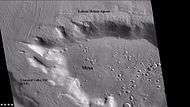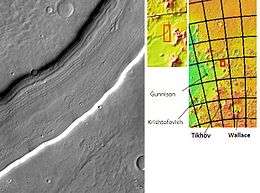Lobate debris apron
Lobate debris aprons (LDAs) are geological features on Mars, first seen by the Viking Orbiters, consisting of piles of rock debris below cliffs.[1][2] These features have a convex topography and a gentle slope from cliffs or escarpments, which suggest flow away from the steep source cliff. In addition, lobate debris aprons can show surface lineations as do rock glaciers on the Earth.[3]
 Wide view of mesa with CTX showing Cliff face and location of lobate debris apron (LDA) Location is Ismenius Lacus quadrangle.
Wide view of mesa with CTX showing Cliff face and location of lobate debris apron (LDA) Location is Ismenius Lacus quadrangle. Enlargement of previous CTX image of mesa This image shows the cliff face and detail in the LDA. Image taken with HiRISE under HiWish program. Location is Ismenius Lacus quadrangle.
Enlargement of previous CTX image of mesa This image shows the cliff face and detail in the LDA. Image taken with HiRISE under HiWish program. Location is Ismenius Lacus quadrangle. Lobate debris aprons (LDAs) around a mesa, as seen by CTX. Mesa and LDAs are labeled so one can see their relationship. Radar studies have determined that LDAs contain ice; therefore, these can be important for future colonists of Mars. Location is Ismenius Lacus quadrangle.
Lobate debris aprons (LDAs) around a mesa, as seen by CTX. Mesa and LDAs are labeled so one can see their relationship. Radar studies have determined that LDAs contain ice; therefore, these can be important for future colonists of Mars. Location is Ismenius Lacus quadrangle. Close-up of lobate debris apron (LDA), as seen by HiRISE under HiWish program
Close-up of lobate debris apron (LDA), as seen by HiRISE under HiWish program- Lobate debris apron in Phlegra Montes, as seen by HiRISE. The debris apron is probably mostly ice with a thin covering of rock debris, so it could be a useful source of water. Scale bar is 500 meters long.
 Close-up of surface of a lobate debris apron in Hellas quadrangle. Note the lines that are common in rock glaciers on the Earth.
Close-up of surface of a lobate debris apron in Hellas quadrangle. Note the lines that are common in rock glaciers on the Earth. View of a lobate debris apron along a slope in Arcadia quadrangle.
View of a lobate debris apron along a slope in Arcadia quadrangle. Place where a lobate debris apron begins. Note stripes which indicate movement. Image located in Ismenius Lacus quadrangle.
Place where a lobate debris apron begins. Note stripes which indicate movement. Image located in Ismenius Lacus quadrangle.
The Mars Reconnaissance Orbiter's Shallow Radar gave a strong reflection from the top and base of LDAs, meaning that pure water ice made up the bulk of the formation (between the two reflections).[4] This is evidence that the LDAs in Hellas Planitia are glaciers covered with a thin layer of rocks.[5][6][7][8][9]
The experiments of the Phoenix lander and the studies of the Mars Odyssey from orbit show that frozen water exists just under the surface of Mars in the far north and south (high latitudes). Most of the ice was deposited as snow when the climate was different.[10] The discovery of water ice in LDAs demonstrates that water is found at even lower latitudes. Future colonists on Mars will be able to tap into these ice deposits, instead of having to travel to much higher latitudes. Another major advantage of LDAs over other sources of Martian water is that they can easily be detected and mapped from orbit. Lobate debris aprons are shown below from the Phlegra Montes which are at a latitude of 38.2 degrees north. The Phoenix lander set down at about 68 degrees north latitude, so the discovery of water ice in LDAs greatly expands the range of water easily available on Mars.[11] It is far easier to land a spaceship near the equator of Mars, so the closer water is available to the equator the better it will be for colonists.
Lineated floor deposits
The floors of some channels show ridges and grooves that seem to flow around obstacles; these features are called lineated floor deposits or lineated valley fill (LVF). Like lobate debris aprons, they are believed to be ice-rich. Some glaciers on the Earth show such features.
It has been suggested that lineated floor deposits began as LDAs.[12][13] By tracing the paths of the curved ridges characteristic of LDAs, researchers have come to believe that they straighten out to form the ridges of LVF.[14][15][16][17] Both lineated floor deposits and lobate debris aprons often display a strange surface formation called brain terrain because it looks like the surface of the human brain.[18]
 Wide CTX view showing mesa and buttes with lobate debris aprons and lineated valley fill around them. Location is Ismenius Lacus quadrangle.
Wide CTX view showing mesa and buttes with lobate debris aprons and lineated valley fill around them. Location is Ismenius Lacus quadrangle. Close-up of lineated valley fill (LVF), as seen by HiRISE under HiWish program Note: this is an enlargement of the previous CTX image.
Close-up of lineated valley fill (LVF), as seen by HiRISE under HiWish program Note: this is an enlargement of the previous CTX image. Wide CTX view of mesa showing lineated valley fill and lobate debris apron (LDA). Both are believed to be debris-covered glaciers. Location is Ismenius Lacus quadrangle.
Wide CTX view of mesa showing lineated valley fill and lobate debris apron (LDA). Both are believed to be debris-covered glaciers. Location is Ismenius Lacus quadrangle. Close-up of lobate debris apron from the previous CTX image of a mesa. Image shows open-cell brain terrain and closed-cell brain terrain, which is more common. Open-cell brain terrain is thought to hold a core of ice. Image is from HiRISE under HiWish program.
Close-up of lobate debris apron from the previous CTX image of a mesa. Image shows open-cell brain terrain and closed-cell brain terrain, which is more common. Open-cell brain terrain is thought to hold a core of ice. Image is from HiRISE under HiWish program. Closed-cell brain terrain, as seen by HiRISE under the HiWish program. This type of surface is common on lobate debris aprons, concentric crater fill, and lineated valley fill.
Closed-cell brain terrain, as seen by HiRISE under the HiWish program. This type of surface is common on lobate debris aprons, concentric crater fill, and lineated valley fill. Open and closed-cell brain terrain, as seen by HiRISE, under HiWish program.
Open and closed-cell brain terrain, as seen by HiRISE, under HiWish program.
Reull Vallis, pictured below, displays these deposits.[19] Sometimes the lineated floor deposits show a chevron pattern which is further evidence of movement. The picture below taken with HiRISE of Reull Vallis shows these patterns.
Gallery
- Map of the eastern part of Hellas Planitia (a vast impact crater), showing two large river valleys that slope left, toward the floor of the crater.
 Reull Vallis with lineated floor deposits, as seen by THEMIS. Click on image to see relationship to other features.
Reull Vallis with lineated floor deposits, as seen by THEMIS. Click on image to see relationship to other features.- Niger Vallis with features typical of this latitude, as seen by HiRISE. Chevron pattern results from movement of ice-rich material. Click on image to see chevron pattern and mantle.
- Material moving down slope in Phlegra Montes, as seen by HiRISE. Movement is probably aided by water/ice.
See also
References
- ↑ Carr, M. 2006. The Surface of Mars. Cambridge University Press. ISBN 978-0-521-87201-0
- ↑ Squyres, S. 1978. Martian fretted terrain: Flow of erosional debrid. Icarus: 34. 600-613.
- ↑ ISBN 0-8165-1257-4
- ↑ http://www.planetary.brown.edu/pdfs/3733.pdf
- ↑ Head, J. et al. 2005. Tropical to mid-latitude snow and ice accumulation, flow and glaciation on Mars. Nature: 434. 346-350
- ↑ http://www.marstoday.com/news/viewpr.html?pid=18050
- ↑ http://news.brown.edu/pressreleases/2008/04/martian-glaciers
- ↑ Plaut, J. et al. 2008. Radar Evidence for Ice in Lobate Debris Aprons in the Mid-Northern Latitudes of Mars. Lunar and Planetary Science XXXIX. 2290.pdf
- ↑ Holt, J. et al. 2008. Radar Sounding Evidence for Ice within Lobate Debris Aprons near Hellas Basin, Mid-Southern Latitudes of Mars. Lunar and Planetary Science XXXIX. 2441.pdf
- ↑ Madeleine, J. et al. 2007. Exploring the northern mid-latitude glaciation with a general circulation model. In: Seventh International Conference on Mars. Abstract 3096.
- ↑ http://www.planetary.org/explore/topics/phoenix
- ↑ Sourness, C., B. Hubbard, R. Milliken, D. Quincey. 2012. An inventory and population-scale analysis of martian glacier-like forms. Icarus 217, 243-255.
- ↑ Souness, C. and B. Hubbard. 2013. An alternative interpretation of late Amazonian ice flow: Protonilus Mensae, Mars. Icarus 225, 495-505.
- ↑ Head, J. & D. Marchant (2006). "Modification of the walls of a Noachian crater in northern Arabia Terra (24E, 39N) during mid-latitude Amazonian glacial epochs on Mars: Nature and evolution of lobate debris aprons and their relationships to lineated valley fill and glacial systems". Lunar Planet. Sci. 37: Abstract # 1126.
- ↑ Kress, A., J. Head (2008). "Ring-mold craters in lineated valley fill and lobate debris aprons on Mars: Evidence for subsurface glacial ice". Geophys. Res. Lett. 35: L23206-8. doi:10.1029/2008gl035501.
- ↑ Baker, D.; et al. (2010). "Flow patterns of lobate debris aprons and lineated valley fill north of Ismeniae Fossae, Mars: Evidence for extensive mid-latitude glaciation in the Late Amazonian". Icarus. 207: 186–209. Bibcode:2010Icar..207..186B. doi:10.1016/j.icarus.2009.11.017.
- ↑ Kress., A. & J. Head (2009). "Ring-mold craters on lineated valley fill, lobate debris aprons, and concentric crater fill on Mars: Implications for near-surface structure, composition, and age". Lunar Planet. Sci. 40: abstract 1379.
- ↑ Levy, J.; et al. (2009). "Concentric crater fill in Utopia Planitia: History and interaction between glacial "brain terrain" and periglacial processes". Icarus. 202 (2): 462–476. Bibcode:2009Icar..202..462L. doi:10.1016/j.icarus.2009.02.018.
- ↑ http://themis.asu.edu/zoom-20021022a